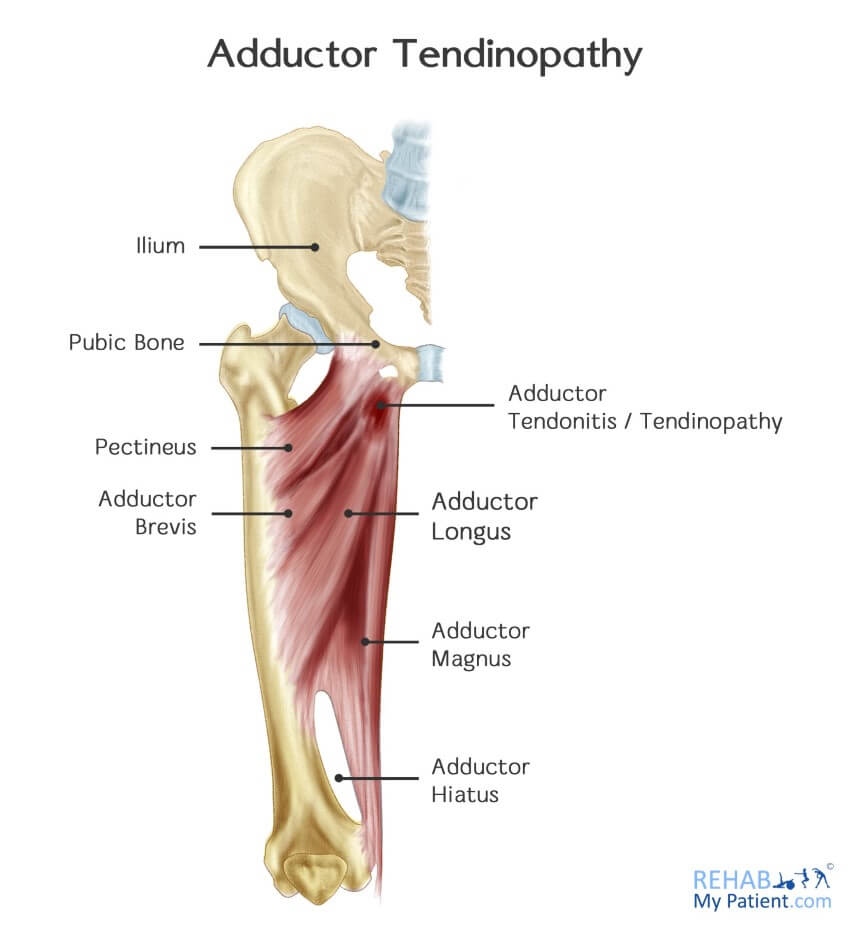
Adductor tendinopathy is a condition that is characterized by damage to the tissue and an inflammation of the adductor tendon where it attaches to the pelvis, which leads to groin pan. When it comes to the adductor muscles, they are responsible for stabilization of the pelvis and moving the leg to the middle part of the body (adduction). They tend to be most active when running, especially when it comes to changing directions, and kicking.
During the contraction of the groin muscles, a tremendous amount of tension is placed through the tendon where it attaches to the pelvis. When the tension becomes too much because of an excessive amount of force and repetition, damage to the tendon can occur. Adductor tendinopathy happens when there is damage to the tendon accompanied by inflammation and/or degeneration.
Adductor Tendinopathy Anatomy
The muscles drawing the leg inward are the adductor longus, pectineus, adductor magnus, gracilis and adductor brevis. All of these muscles arise from the pubic bone.
Adductor tendinopathy is often the result of overusing the area, which commonly occurs from prolonged or repetitive activities that place strain on the tendon. Patients can end up developing the condition suddenly due to an intense contraction of this muscle when they are in a stretched position. Typically, this occurs when the individual rapidly accelerates when running or if a soccer player performs a long kick.
This condition is often seen in football, athletics, soccer and hockey, as well as in horse riding, skiing and gymnastics. Patients might end up developing the condition following inadequate or inappropriate treatment of a strain.

How to treat adductor tendinopathy:
- Manual Therapy
Most individuals with the condition will be able to heal properly using manual therapy. Working with a trained professional can help you to strengthen the ligaments, muscles and joints surrounding the injured site. Participating in a graduated strengthening and flexibility program with a trained therapist is imperative to reconditioning the muscles and reduce the chance of the injury occurring again. Carefully assessing the factors that contributed to the condition and correcting those factors is imperative to achieving a full outcome.
- Rest
One of the main factors that attribute to a full recovery is being able to rest adequately from activities that increase the pain until free of symptoms. Activities that place tremendous amounts of stress on the groin need to be kept at a minimum, such as running, jumping or kicking. By avoiding all of these activities, the body will be able to begin the healing process when further tissue damage is absent. Once activities can be performed without pain, you can gradually return to these activities as long as there is no pain in the groin region. Gradually return to your regular activities as allowed. - Ice and Heat
Using contrast bathing (ice and heat alternated) can be particularly useful to stimulate blood flow to an area with tendinopathy, and this can speed up healing.
Tips:
- Poor posture has been attributed to injuries in the adductor muscle.
- When participating in an exercise program, make sure to adequately warm-up beforehand.
- Maintaining an adequate weight is important to keeping your joints and muscles healthy.
- Practice proper running techniques when participating in sports. If you are not sure, ask a coach.
- Allow your body proper time to recover from any sporting activities.
Sign Up
Sign up for your free trial now!
Get started with Rehab My Patient today and revolutionize your exercise prescription process for effective rehabilitation.
Start Your 14-Day Free Trial